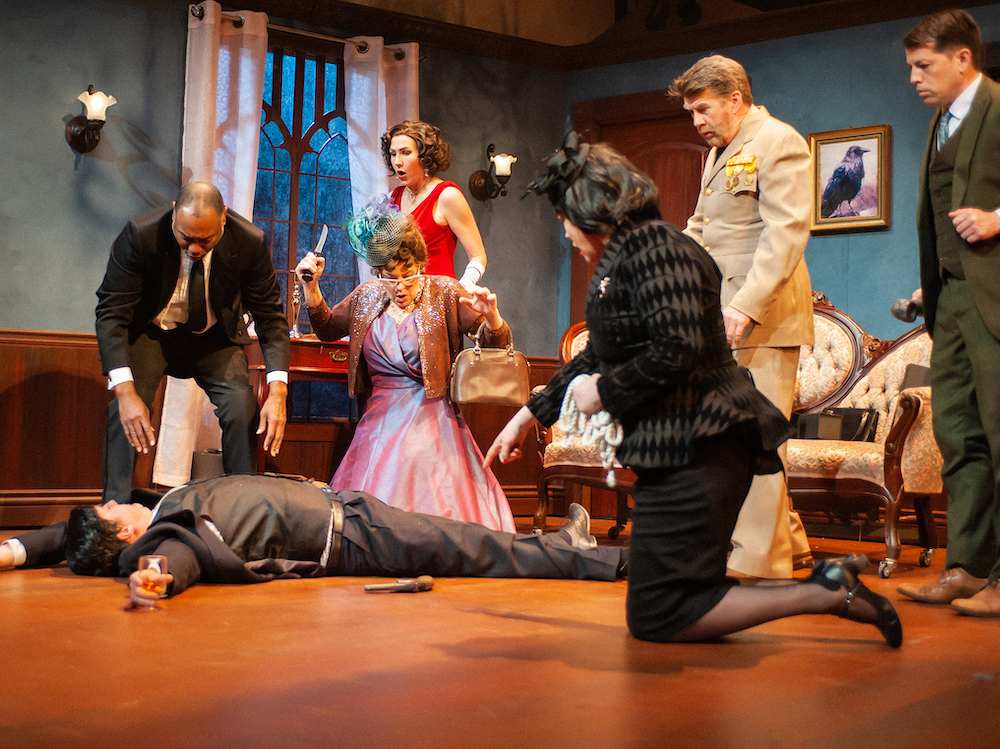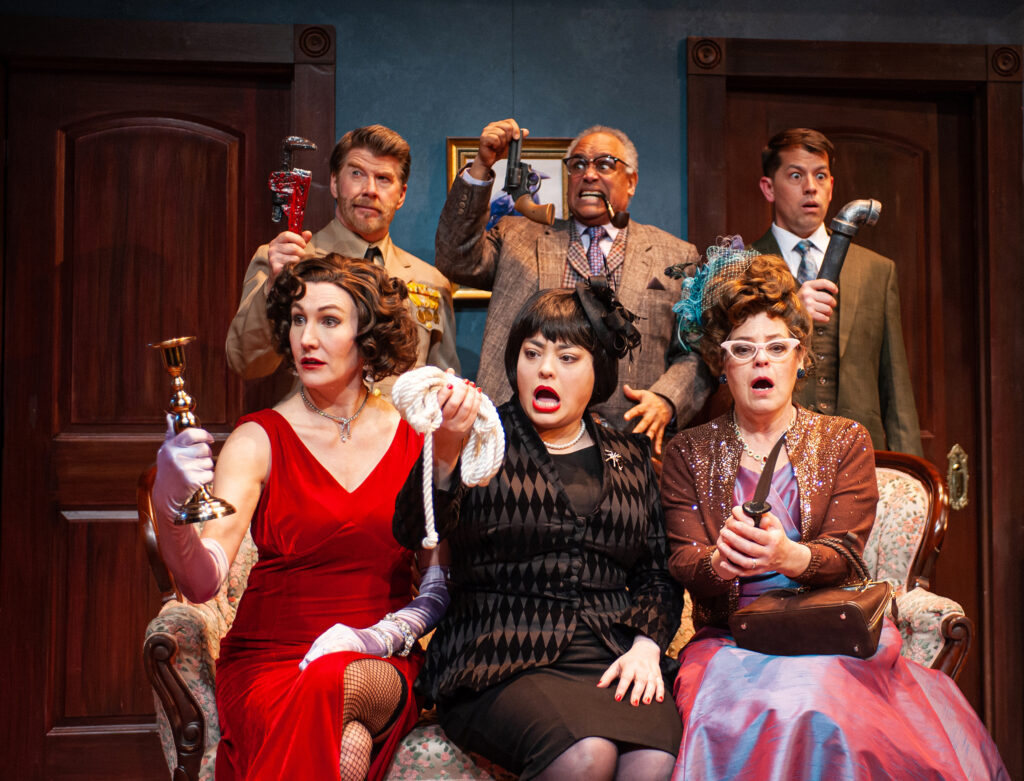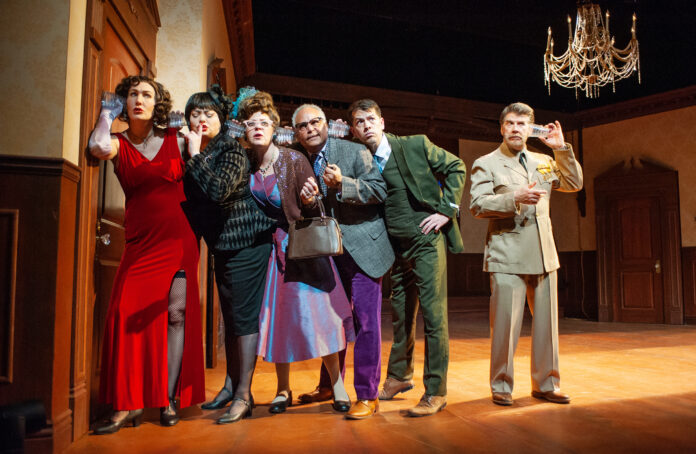I’m often not a fan of film-to-stage translations. The reverse can be brilliant, blasphemous, or anywhere in-between, but film-to-stage adaptations are especially prone to losing something in the translation. Theatre is a medium meant to project up to those in the nose-bleed section, whilst film is medium of the extreme close-up. Yes, theatre can be nuanced and film can be over-the-top, but if you don’t understand why each is known for those particular traits, then you won’t be adapting so much as making a pale imitation.
As you may have guessed, the above popped into my head as watched the first Sunday masked matinee for Clue (runs through April 22 at the SF Playhouse.)
Though obviously based on the classic English board game (originally titled “Cluedo”), this Sandy Rustin adaptation with additional material by Hunter Foster and Eric Price is open about the fact that it’s based on the beloved film. That version by Jonathan Lynn and co-written by Lynn and Jon Landis put the story in the midst of the Red Scare, making the characters’ colorful names into clandestine aliases used by extortionist Mr. Boddy. The film was a notorious flop during its initial run, but immediately gained a cult following through home video and cable TV. Both family-friendly and infinitely-quotable, it’s the rare murder-mystery you can show your kids, and an excellent showcase for some of Hollywood’s funniest comedic actors of the time.

This stage version of Clue is much like Carrie: The Musical (any version): it just cranks up the volume on memorable moments, hoping that they’ll land even better when done louder. The paradoxical result is that by doing them louder, they strip all impact away.
For instance, watching the film as a youngster makes you feel smart when you realize that Professor Plum’s job at the UN and the WHO means he works for U.N.O.W.H.O. It’s subtle, it’s funny, it takes two seconds of screen time. Contrast that with this stage version, which literally and figuratively spells out the fact that the good professor (Michael Gene Sullivan) works for “You-Know-Who.”
Part of this obviously comes from the script by Rustin and co., but some of it may also be the work of director/Playhouse co-founder Susi Damilano. Herself a fine performer, her directorial track record is often defined by whatever genre she’s working in: she excels and directing drama and clearly loves musicals (having directed one of the best productions of Cabaret I’ve ever seen live); but she’s always struggled with comedy. She tends to draw out jokes, adding unnecessary “air” to scenes that are meant to fly by rapidly. Such was the case in 2017, when she stretched out Noises Off! to an interminable two-and-a-half hours. She makes the same mistake here, dragging out lines and sequences that were meant to move at the pace of a machine gun.
Of course, Rustin and co. don’t really give her or her cast much to work with. When the script isn’t over-explaining lines like a Seth McFarlane sitcom, it’s switching lines between characters. A paragraph of dialogue spoken by one character in the film, will be spoken by another here, thus ruining any character consistency. Rustin and co. don’t see these people as characters, just as joke-distributors. And that’s when they’re not tossing in poor meta laughs (the ladies responding to sexual harassment by shouting “me too!” or someone mentioning the house was built by “the Parker Brothers) and having its talented cast mug as though they were pandering to babies. Stacy Ross is one of the most electrifying performers in the Bay Area, yet I didn’t even know she was playing Mrs. Peacock until reading the program. She had no opportunity to show the timing and energy for which she’s known.

As I mentioned, I saw the show on the Sunday of opening weekend, during one of the Playhouse’s new masked matinees. To the company’s credit, they were pretty consistent about people being covered up in order to get inside. Playhouse audiences being who they are, a few people removed theirs once inside, with no one official telling them to put them back on (one woman took off her mask and took photos mid-show, also violating the company’s “no mobile devices” rule.) The ventilation of the Playhouse was also good, making things a bit chilly, but keeping my Aranet4’s CO² readings hovering around 580ppm in a nearly-full house.
Oddly enough, the part I most enjoyed about the production was the scenic design by Heather Kenyon. Not only is the set creatively malleable to scene changes, but I was actually transfixed by the old-fashioned lighting sconces at the edge of the stage, the kind you’d see in a theatre open during the 1940s and ‘50s. That set, along Alice Ruiz’s costumes, make the show pretty enough to look at, if nothing else.
Clue is another show that commits the crime of reminding you of where you’ve seen it all before, but better. The script was better in its original film form, the director’s better work lines the halls of the Playhouse itself, and most of the cast are so talented that it would take too long to list all the great things they’ve done. At a mere 90 minutes, the show still feels too long—the last thought one should have for a show that had so many good things going for it.
CLUE runs through April 22. San Francisco Playhouse. Tickets and more info here.




